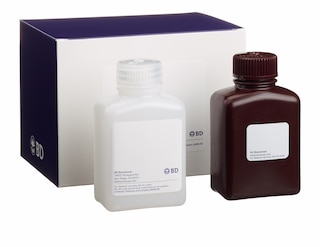Old Browser
This page has been recently translated and is available in French now.
Looks like you're visiting us from {countryName}.
Would you like to stay on the current country site or be switched to your country?


.png)

Flow cytometric analysis of APC-conjugated anti-mouse IgG1 second step. Freshly isolated BALB/c splenocytes were incubated with the primary purified antibody for mouse CD22.2 (clone Cy34.1, solid line) followed by APC-conjugated anti-MouseIgG1 as second step (Clone A85-1, Cat.No. 560089) and compared to an APC-conjugated isotype control (Cat. No. 554686, dashed line). Flow cytometry was performed on a BD FACSCalibur™ System and the histograms were derived from the gated events based on light scattering characteristics of viable splenocytes.
.png)

BD Pharmingen™ APC Rat anti-Mouse IgG1
.png)
Regulatory Status Legend
Any use of products other than the permitted use without the express written authorization of Becton, Dickinson and Company is strictly prohibited.
Preparation And Storage
Recommended Assay Procedures
APC-conjugated A85-1 antibody may be used as a primary or secondary reagent in immunofluorescent staining.
IMMUNOFLUORESCENT STAINING OF INTRACELLULAR IMMUNOGLOBULIN (Ig) PROTOCOL
1. Prepare a single-cell suspension and determine cell number.
2. Suspend cells in staining buffer (PBS + 2% FBS + 0.1% Sodium Azide) at 2 x 10^7 cells/ml and transfer to U-bottom microwell plates in 50 µl/well for immunofluorescent staining.
Note: The BD Pharmingen™ Stain Buffer with FBS (Cat. No. 554656) is effective for use as a staining buffer in this protocol.
3. Block Fcγ receptors by adding 0.2 µg of purified 2.4G2 antibody (Mouse BD Fc Block™ purified anti-mouse CD16/CD32 mAb 2.4G2) (Cat. No. 553141/553142) in 50 µl of staining buffer to each well.
4. Incubate 5 minutes on ice.
5. Add 200 µl of staining buffer/well and resuspend cells. Centrifuge at 250 x g for 5 minutes and aspirate supernatant.
6. Block surface Ig with purified A85-1 mAb (Cat. No. 553440) by adding 1.0 µg per sample in 50 µl of staining buffer/well.
Note: Surface markers may be stained during this step as described in the "Immunofluorescent Staining of Mouse and Rat Leukocytes for Flow Cytometry" in the Technical Protocols section of our website at http://www.bdbiosciences.com/support/resources/protocols/mouse_rat_leukocytes.jsp
7. Incubate 15 minutes on ice.
8. Wash 2x as described in Step 5.
9. Resuspend cells in 100 µl of BD Cytofix/Cytoperm™ intracellular staining buffer (BD Cytofix/Cytoperm™ Kit, Cat. No. 554714) per well.
10. Incubate 30 minutes at room temperature.
11. Wash 2x with 200 µl of 1x Perm/Wash buffer (provided in the BD Cytofix/Cytoperm Kit) per well. Centrifuge at 250 x g for 5 minutes and aspirate supernatant between washes.
12. Stain intracellular Ig by adding ≤1 µg of APC-conjugated A85-1 mAb in 50 µl of 1 x Perm/Wash buffer/well.
Note: Other antibodies recommended for staining of intracellular markers may be added during this step as described in Step 12.
13. Incubate for 30 minutes at room temperature.
14. Wash 2x as described in Step 11.
15. Resuspend and transfer samples in 100 µl of staining buffer to tubes appropriate for analysis with a flow cytometer. Bring volume in each tube to 400 µl with staining buffer.
16. Analyze samples on a flow cytometer.
Product Notices
- Since applications vary, each investigator should titrate the reagent to obtain optimal results.
- Caution: Sodium azide yields highly toxic hydrazoic acid under acidic conditions. Dilute azide compounds in running water before discarding to avoid accumulation of potentially explosive deposits in plumbing.
- This APC-conjugated reagent can be used in any flow cytometer equipped with a dye, HeNe, or red diode laser.
- For fluorochrome spectra and suitable instrument settings, please refer to our Multicolor Flow Cytometry web page at www.bdbiosciences.com/colors.
- Please refer to www.bdbiosciences.com/us/s/resources for technical protocols.
Companion Products



.png?imwidth=320)
The A85-1 antibody reacts specifically with mouse IgG1 of Igh-Ca and Igh-Cb haplotypes. It does not react with other Ig isotypes. Detection of surface immunoglobulin on B lymphoma cells has been demonstrated with the A85-1 monoclonal antibody. A suspension of pooled mouse IgG1 was used as the source of immunogen.

Please refer to Support Documents for Quality Certificates
Global - Refer to manufacturer's instructions for use and related User Manuals and Technical data sheets before using this products as described
Comparisons, where applicable, are made against older BD Technology, manual methods or are general performance claims. Comparisons are not made against non-BD technologies, unless otherwise noted.
For Research Use Only. Not for use in diagnostic or therapeutic procedures.
Report a Site Issue
This form is intended to help us improve our website experience. For other support, please visit our Contact Us page.